Morris & Fan. Reservoir Sedimentation Handbook
Подождите немного. Документ загружается.


FLUSHING 15.4
released from an upstream reservoir will accumulate in a downstream reservoir unless all
the reservoirs are managed conjunctively. The environmental consequences of reservoir
emptying and potential remedial measures are discussed in Chap. 18.
15.2 FEATURES OF FLUSHING
15.2.1 Flushing Channel Geometry for Fine Sediment
Flushing scours a single main channel through beds of fine sediment while floodplain
deposits on either side of the channel are unaffected by erosion. The plan and
longitudinal view of a flushing channel is illustrated in Fig. 15.3. During impounding,
both channel and floodplain are submerged, and continued sedimentation causes
floodplain deposits to increase in height while the main channel is maintained by
repeated flushing as previously shown in Fig. 15.2. The bottom width W of the flushing
channel is determined by hydraulic conditions, and the slope of the channel wall is
determined by the angle of repose of the deposits. In areas of fine sediment deposits, the
main channel usually follows the original pre-impoundment river course.
15.2.2 Accumulation of Coarse Sediment Deposits during Flushing
Flushing periods do not necessarily coincide with major floods, as in the case of a reser-
voir which is flushed during the first month of a 3-month wet season, and a significant
amount of bed material can be delivered to and trapped within the reservoir during
impounding periods. This is quite different from sediment routing or pass-through for bed
material in which large-capacity gates are operated during flood events, whenever they
occur, to maintain transport capacity through the impounded reach when the inflow of
bed load is significant. As a result, the accumulation of coarse sediment in the form of
delta deposits can become a serious problem, even though the accumulation of fine
sediment is successfully controlled by flushing.
Flushing is conducted during only part of the year, and sediment transport capacity
through a reservoir operated for flushing is less than in the upstream channel. If flushing
flows are of insufficient discharge and duration to transport all of the inflowing load,
coarse material above a certain diameter and which is supply-limited in the river reach
above the reservoir, will become transport-limited and accumulate within the impounded
reach. The zone of coarse sediment accumulation within a reservoir that is flushed will
depend on the water level during large discharge events, which is a function of
impounding operations and the backwater produced by the flushing outlet. The zone of
deposition for bed material can also be influenced by previous delta deposition which
elevates the base level of the stream, reducing stream slope and causing deposition
upstream of the delta regardless of the water level during a flood event.
Patterns of coarse sediment accumulation in reservoirs subject to flushing have rarely
been documented. At several flushing sites bed material has been observed to deposit as a
delta in the upper portion of the reservoir, similar to the pattern commonly observed in
conventionally operated impounding reservoirs. Chen and Zhao (1992) describe the case
of the gorge-shaped 10.2 Mm
3
Nangin irrigation reservoir in Shaanxi Province, China,
which experienced a major flood in 1975, its second year of operation. This flood
mobilized gravels in the streambed and created backwater deposits 3 to 4 m thick 1 km
above the original pool limit, and the zone of deposition extended 2.2 km above the 4.0
km long reservoir pool. The original bed slope averaged 0.006, and the slope in the area
of deposits ranged from 0.0014 to 0.0056. As bed material was deposited in the upstream

FLUSHING 15.5
FIGURE 15.3 Plan and thalweg profile for flushing operations illustrating longitudinal pattern o
f
sediment redistribution during a flushing event: (a) impounding period with deliveries to
downstream users; (b) drawdown with erosion in the upper reach of the flushing channel an
d
redeposition near the dam, with pressure flow through the bottom outlet; (c) complete drawdown
causing erosion along the length of the reservoir with free flow through bottom outlet.
reach, de
gradation of previously deposited material occurred further downstream. Over a
period of years it was observed that large inflow events caused aggradation of the bed
due to the large inflowing sediment load, and these deposits were scoured during years
lacking large floods. However, because the rate of scour was low, there is a net
accumulation of gravels.
At Cachí Reservoir, coarse material accumulates in the form of a delta at the upstream
limit of the normal pool because the annual inflow of coarse sediment exceeds the
volume removed during flushing (1 month of drawdown and 3 days flushing). The delta
gradually advances toward the dam, burying both the floodplain deposits and the flushing
channel. The upper basin of Cachí reservoir accumulated 4 to 6 Mm
3
of coarse material
between 1966 and 1990. Despite annual flushing, these deposits have grown to 8 to 12 m
FLUSHING 15.6
in thickness. Coarse bed materials are also encroaching at Hengshan Reservoir, China, in
the form of a broad delta containing sand and gravel. The contrast in deposition
conditions in the delta area and near the dam is evident in Fig. 15.4. Although flushing
has been effective in removing silts from Hengshan reservoir, the delta is continuously
aggrading. At both Cachí and Hengshan Reservoirs the flushing flow crosses the coarse
delta deposits as a braided or wide and shallow stream, instead of the deep incised
channel typical of the downstream portion of the reservoir.
A second pattern which is also anticipated, but not known to have been documented,
is the gradual increase along the bed elevation of the flushing channel downstream of the
delta due to the deposition of coarse sediment. The accumulation of coarse bed material
in the flushing channel may cause lateral shifting of the flushing channel as its bed
elevation rises and fine-grain floodplain deposits on the channel banks are eroded.
The rate of delta accumulation varies widely between reservoirs, depending on the
difference between the rate of coarse sediment delivery and its removal by flushing
flows. Armoring can limit the erosion rate of delta deposits by flushing discharge. The
volume and grain size of the coarse sediment released by reservoir flushing can increase
over time as deposits advance toward the dam, increasing the slope and transport capacity
of the flushing channel. Additional bed material accumulation upstream of the delta
should also be anticipated.
15.2.3 Channel Formation and Maintenance
When flushing is initiated at a reservoir that has been accumulating sediment for a num-
ber of years, two distinct flushing phases may be identified. During the first, or channel
formation, phase, existing deposits are eroded to create the main flushing channel, plus
any auxiliary lateral or longitudinal flushing channels. During this phase a portion of the
reservoir capacity can be recovered. During the second, or channel maintenance phase,
the flushing channels have already reached their equilibrium size and only recently
deposited sediment is flushed out of the channels. Maintenance flushing is typically
practiced on an annual basis, although both shorter and longer intervals have been used.
Depending on site characteristics and flushing flows, channel formation may require
several years of flushing operations. Maintenance flushing must continue indefinitely to
sustain sediment control benefits.
During impounding periods much of the fine sediment entering a reservoir tends to
deposit in the lowest part of each cross section, especially when turbidity currents are
present. When a channel is maintained by flushing, sediment deposition becomes focused
within the channel and can be removed during the next flushing event. There are four
mechanisms by which flushing reduces sediment accumulation: (1) previously deposited
material is removed; (2) sediment entering the reservoir during the flushing period will be
routed along the channel and released through the low-level outlet; (3) while impounding
sediment deposition is focused in the channel, from which it can be scoured during the
next flushing event; and (4) the flushing channel geometry facilitates the movement of
turbidity currents toward the dam where they can be released.
The potential importance of the flushing channel in focusing suspended sediment
inflow is illustrated by data from the Cachí Reservoir case study. Cachí Reservoir is
divided into upper and lower pools by a natural constriction. Because delta deposition of
coarse sediment affects most of the upper pool but not the lower, only the lower pool is
used in these computations. The flushing channel at Cachí occupies only 9.5 percent of
the total surface area of the lower reservoir pool, yet 71 percent of the total inflowing
solids load (76 percent of suspended load) either flows as a turbidity current along the
submerged channel to the dam where it is discharged through the power intake, or is
deposited within the channel and subsequently removed by flushing. The remaining
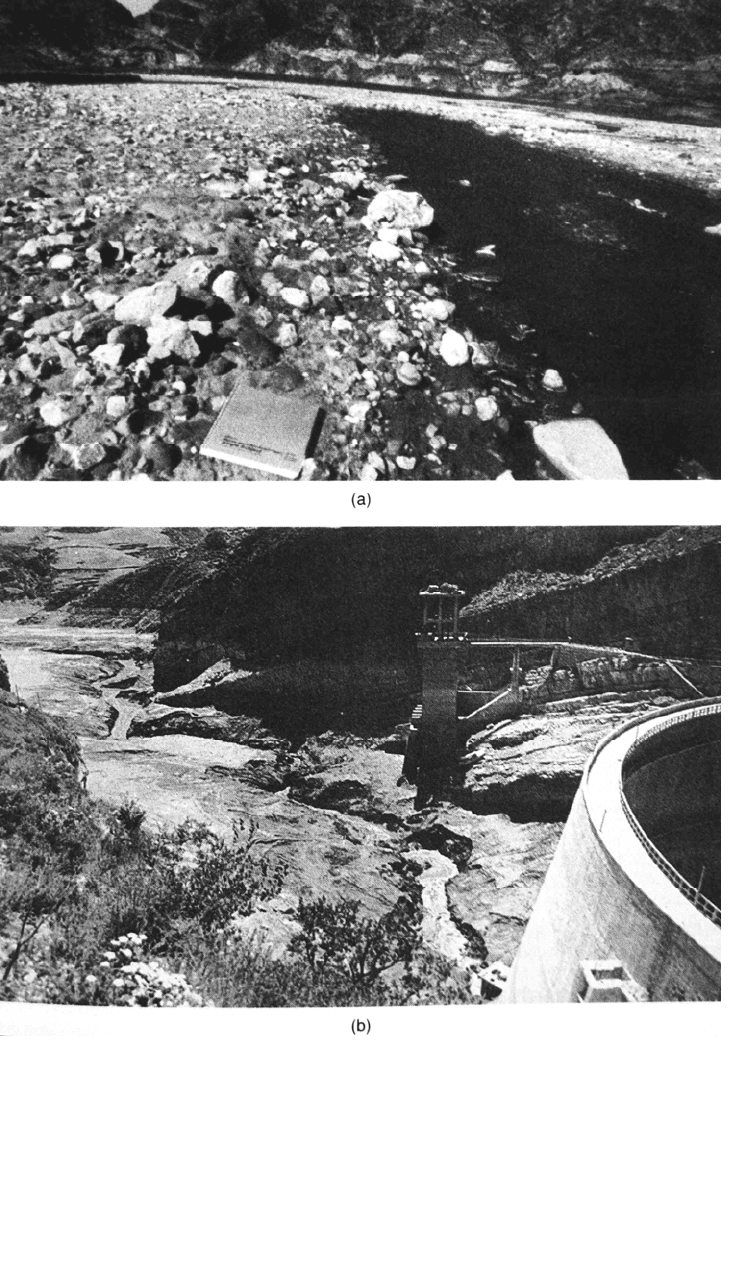
FLUSHING 15.7
solids are deposited on the submerged floodplain that occupies 90.5 percent of the solids
FIGURE 15.4 Hengshan Reservoir, China. (a) View looking downstream across the delta that is
encroaching into the reservoir. Although flushing is effective in removing the silts, this delta
containing coarse material is continuously advancing toward the dam. (b) View of flushing channel
in deposits of silty material near the dam.
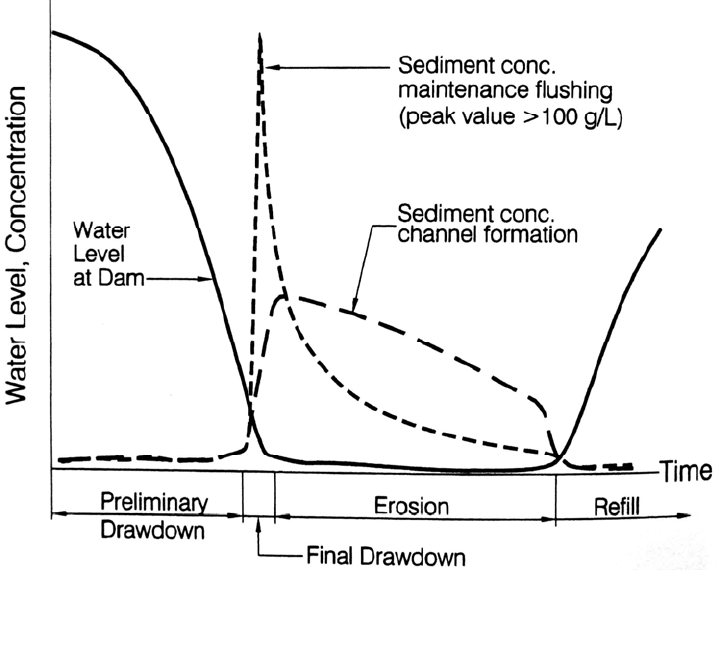
FLUSHING 15.8
sediments are deposited on the submerged floodplain that occupies 90.5 percent of the
reservoir area. The percent of inflowing sediment deposited in the flushing channel
depends on site characteristics such as the top width of the channel compared to the full
reservoir cross section, the tendency for turbid density currents to form, the hydraulic
capacity of the flushing channel, and the operational rule. This question has not been
researched in detail.
15.2.4 Flushing Procedures
Each flushing event has three distinct stages: drawdown, erosion, and refill. The char-
acteristic behavior of hydraulic and sediment parameters during flushing are summarized
in Fig. 15.5. Reduction in water level to initiate flushing, the drawdown stage, may
FIGURE 15.5 Hydraulic and sediment characteristics for channel formation and channel
maintenance flushing events at constant discharge.
usually be divided into two parts. Preliminary drawdown brings the reservoir to the
minimum operational level by delivering water to users or hydropower turbines and typ-
ically occurs over a period of days or weeks. Final drawdown involves rapid emptying of
the reservoir below the minimum operational level using the bottom outlets and usually
occurs over a short period of time, on the order of a few hours in smaller reservoirs.
Complex patterns of sediment movement can occur during drawdown. During draw-
down, sediments from the upper end of the reservoir can be mobilized and transported
downstream where they will be redeposited in the lowered pool, as illustrated by the
adjustment in the sediment profile in Fig. 15.3b. A turbidity current may also be formed

FLUSHING 15.9
TABLE 15.1 Several Periods of Drawdown Flushing with Density Current Venting at
Sanmenxia Reservoir, China, 1962
Period, 1962
1
3/21-4/9
2
4/9-4/20
3
5/16-6/16
4
8/20-8/27
5
9/8-9/25
6
10/15-11/8
Water level, m 308.6 306.0 303.8 310.1 308.5 309.4
Inflow Q, m
3
/s 1120 780 446 1400 1380 1610
Outflow Q, m
3
/s 1200 768 428 1625 1290 1460
Concentration at selected ranges, g/L:
R41 16.3 18.9 12.7 19.9 27.2 17.1
R31 49.2 27.2 14.8 14.7 18.2 16.7
R22 16.2 20.4 16.6
Outflow 17.7 7.6 5.3 11.7 14.1 9.5
d
50
at selected ranges, mm:
R41 0.063 0.064 0.043 0.043 0.062 0.050
R31 0.038 0.048 0.025 0.032 0.023 0.038
R22 0.023 0.031
Outflow 0.008 0.008 0.008 0.011 0.012 0.011
R41 = 114 km above dam, R31 = 74 km above dam, R22 = 42 km above dam.
Source: Fan (1991).
by the eroded sediment. Individual sediment particles may experience multiple episodes
of erosion and deposition during the draw down period.
Measurements made during partial drawdowns at Sanmenxia Dam during 1962 are
summarized in Table 15.1. During the March-May period, sediment concentration
increased while grain size decreased moving downstream from range R41 to R31, located
respectively 114 and 72 km above the dam (location map, Fig. 24.1). This reflects the
additional entrainment of fine sediment between the two sections, and possibly the simul-
taneous deposition of coarser grains. Downstream of R31, the current encountered the
pool impounded by the dam and plunged to form a turbidity current that was vented at the
dam. There was a significant decrease in both grain size and solids concentration moving
downstream as coarser sediment settled out of the turbidity current.
The erosion stage occurs when riverine flow is established along the full length of the
impoundment, producing high flow velocities that scour fine sediment from the channel
and transport the eroded sediments through the dam. Erosion may continue for a few days
or for weeks, depending on the site, with longer flushing periods required for higher
sediment loads or lower flushing discharges. The refill stage begins on closure of the
bottom outlet, and rising backwater causes sediment to deposit within the impoundment.
Water having a lower sediment concentration may be released during this period to help
scour deposited sediment out of the river channel below the dam.
15.3 EMPTYING AND FLUSHING
15.3.1 Empty Flushing during Flood Season
Some irrigation reservoirs in China are emptied for flushing during the first part of the
flood season, passing early-season floods through the impoundment without significant
detention. The reservoir is refilled during the latter part of the flood season. By incor-

FLUSHING 15.10
porating elements of both sediment routing and sediment flushing, this strategy can be
more effective than either routing or flushing used alone. Downstream irrigation intakes
are supplied from run-of-river flow while the reservoir is empty. Because of the high
sediment concentrations that can be released during the flushing period, the downstream
irrigation canals must be designed to operate at high non-sedimenting velocities.
Seasonal emptying is also feasible when water demand is seasonal, as in the case of
some food processing industries. The Jensanpei (Gen-San-Pee) Reservoir in Taiwan was
constructed to supply a sugar mill that operated only 6 months of the year. Originally
operated to impound water year-round, the reservoir rapidly lost capacity. After 17 years
of conventional operation, a bottom outlet was installed and the reservoir was converted
to seasonal operation, allowing free flow through the reservoir during the part of the year
the mill was not in operation. The operating rule is presented in Fig. 15.6a. As apparent
from the sedimentation history of this reservoir (Fig. 15.6b), this strategy dramatically
reduced the rate of storage loss (King, 1957; Hwang, 1985).
A photograph of the seasonally empty Dashikou irrigation reservoir in China is shown
in Fig. 15.7. Operators at the dam reported that the reservoir began to fill with sediment
rapidly. An outlet about 1.5 × 3 m was installed with a single vertical sluice on the
upstream side. During the initial part of the flood season the reservoir remains empty,
passing all inflow through the low-level outlet. Near the end of the flood season the outlet
is closed to impound for winter irrigation. This procedure was effective in arresting
significant additional deposition and allowed previously deposited material to be flushed
out.
15.3.2 Empty Flushing during Nonflood Season
Flushing can also be successful during the nonflood season, but will typically require a
longer flushing period than flood flushing because of the lower discharge. Limited dis-
charge and inability to route inflowing floods can enhance the tendency for coarse sed-
iment to accumulate, and, because flood season inflow is not routed through the flushing
channel, the rate of sediment deposition on floodplain areas can also be expected to be
higher. A detailed description of flushing during the nonflood season is provided in the
Sefid-Rud case study (Chap. 23).
15.4 FLUSHING WITH PARTIAL DRAWDOWN
Flushing is most effective in preserving reservoir storage when outlets are placed near the
original streambed and the reservoir is completely emptied. However, constraints may
limit either the allowable drawdown or the invert elevation of the flushing outlet,
requiring that flushing be undertaken with only partial reservoir drawdown. Two
examples of this strategy are given. The first is the concept of pressure flushing that was
studied but not implemented at Gebidem Reservoir in Switzerland. In this method the
reservoir is repeatedly drawn down to the minimum operating level and sediment is
evacuated by pressure flow through the bottom outlet. The second example is flushing
with a high-level outlet channel placed at or above the intake level, seasonally diverting
flow from the intakes to the high-level outlet. In this second method, water deliveries are
halted during the flushing period.
15.4.1 Pressure Flushing
Under pressure flushing the reservoir is drawn down to the minimum operating level and
then the bottom outlets are opened, allowing the development of a conical scour hole in
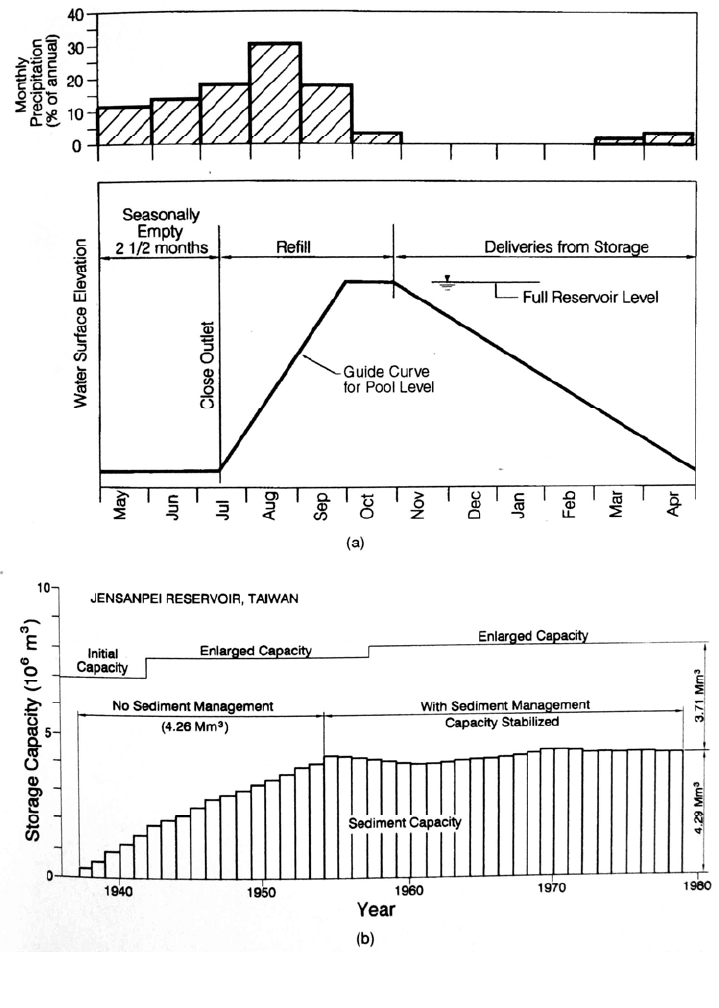
FLUSHING 15.11
FIGURE 15.6 Jensanpei Reservoir in Taiwan: (a) operating rule for flood season
emptying and flushing, and (b) sedimentation history (after Hwang, 1985).
front of the outlet while maintaining the minimum operating level (Fig. 15.8). Sediment
from the upper portion of the reservoir is transported toward the dam during drawdown,
but only material in the scour hole in front of the outlets can be evacuated. At Gebidem
Reservoir, model tests indicated that the scour hole could be evacuated in only 2 to 3
hours, but it would take 20 to 30 hours to refill the hole with sediment. To discharge the
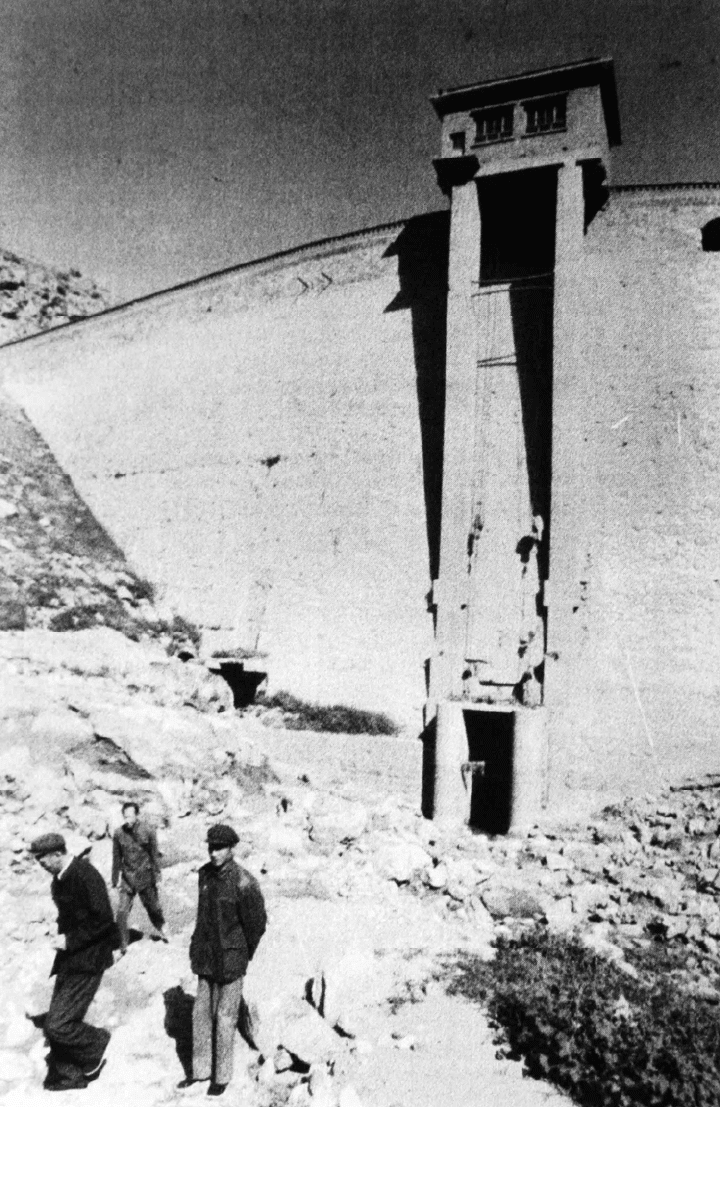
FLUSHING 15.12
FIGURE 15.7 Dashikau irrigation reservoir in China, emptied during the early part of the
flood season for sediment release (G. Morris).
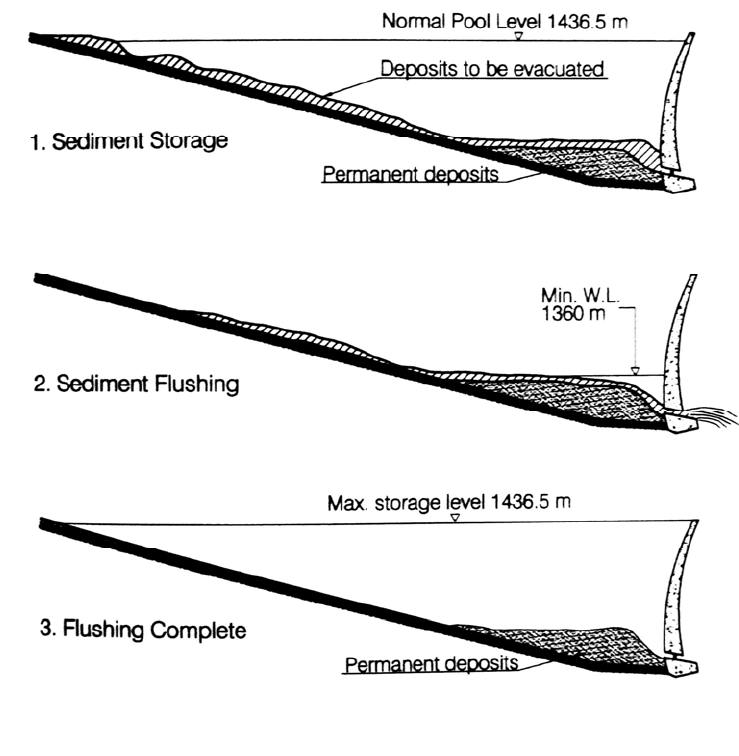
FLUSHING 15.13
FIGURE 15.8 Pressure flushing sequence (after Ullmann, 1970).
anticipated 400,000 to 500,000 m
3
/yr of sediment inflow at this site, 10 to 15 drawdowns
would be required annually (Ullmann, 1970). This is generally not an effective flushing
technique.
15.4.2 Flushing with High-Level Outlet
A proposed method for flushing sandy bed material around Tarbela Dam in Pakistan
using partial drawdown has been described by Lowe and Fox (1995). Tarbela is a 137 m
high embankment dam on the Indus River used for hydropower production (3750 MW
installed capacity) and making up to 5000 m
3
/s of irrigation deliveries. Total capacity was
14,300 Mm
3
at closure in 1974, but 17.4 percent of the total volume had been lost to
sedimentation by 1992. The original project was designed for a 50-year economic life
with no provisions for the eventual management of the inflowing sediment load of about
208 million tons per year. The consequences of sedimentation at this site are
extraordinary.
• Peak summer discharges at Tarbela frequently exceed 8500 m
3
/s. Passage of sand
over spillways, with maximum velocities exceeding 30 m/s in the spillway chutes
